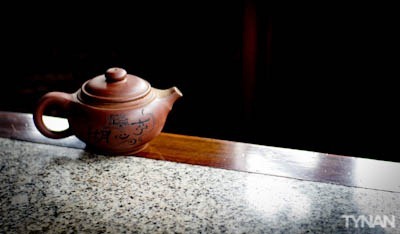Cigarette smoke washes over from the table next to me, where two old Chinese men sip oolong tea from gaiwans. I hate smoke, but don’t mind it today. If we try to replicate our local culture when we travel, we end up with the cookie-cutter resorts of the Caribbean, each with American-style buffets, locals who speak English with a charming accent, and the lonely company of our fellow countrymen, reducing the experience of travel to almost nothing.
It’s the differences from home that create a country’s unique fingerprint and make it worth visiting. Each variance says something about the country. China is ambitious and proud of its heritage and insecure about its place in the world. I’ve only spent three days here and I can see it all around me. It’s also gritty, hence the people driving scooters over pedestrian overpasses and smoking right next to you in a restaurant. It’s part of the experience.
I’m sitting in the top floor of Huxingting tea house, the oldest tea house in Shanghai, rising two stories from a man made island in a man-made lake in the middle of Yuyuan gardens. The bottom floors of the buildings in Yuyuan are renovated and chintzy: they aggressively sell Chinese knick-knacks and serve fast food. Like just about anywhere in the developed world, there are two Starbucks within a two minute walk.
The lacquer-framed windows of Huxingting’s second floor crop the shops and tourists from my view, leaving untouched the upper portions of the surrounding buildings. Ornate red and gold paint coats elaborately carved woodwork as far as I can see. The thick wooden shingles of the classic swooping Chinese roofs around me are warped with age. Only Shanghai’s ultra-modern high rises peeking over these roofs break the illusion of being transported back a couple hundred years.
My pu-erh tea arrives. It’s served in a clay pot, along with a clear glass pot to decant it with and admire it’s deep red-brown color in. I take my first sip, swishing the strong tea around in my mouth. Like all pu-erh teas, it tastes like the a savory clump of bittersweet dirt. Despite every legitimately recognizable note being something you’d never eat (mud, hay, wood, etc.), Pu-erh is enjoyable even the first time you drink it. It doesn’t really make sense.
For an hour I sit and drink tea. Sometimes I steep the tea until it’s the color of dark chocolate, barely permitting light to pass through the glass pot. Other times I infuse it for less than a minute, producing a warm caramel-colored liqueur. I resist the temptation to pull out my Kindle or laptop or phone, and just sit with the tea, stare out at Shanghai, watch other people enjoy their tea, and ponder.
My mind floats between reflecting on my day in Shanghai, thinking about how nice it is to be able to do nothing but drink tea for an afternoon, and through memories conjured from my surroundings and the tea itself.
Smells and tastes create the strongest of memories, and the sharp taste of the pu-erh reminds me of Samovar. This seems backwards at first, considering that Samovar’s pu-erh is sourced only a road trip away from my seat. But then I realize that a good tea is actually a little portal to a different corner of the world. I’d been here before, I just hadn’t realized it.
###
I’m in Tokyo now. heading out around Japan next week or so. I’ve been spending most of my time coding, but have also been spending time with my friends. This weekend I’m going camping in an empty temple in a cave!
Packing video next week!

Leave a Reply